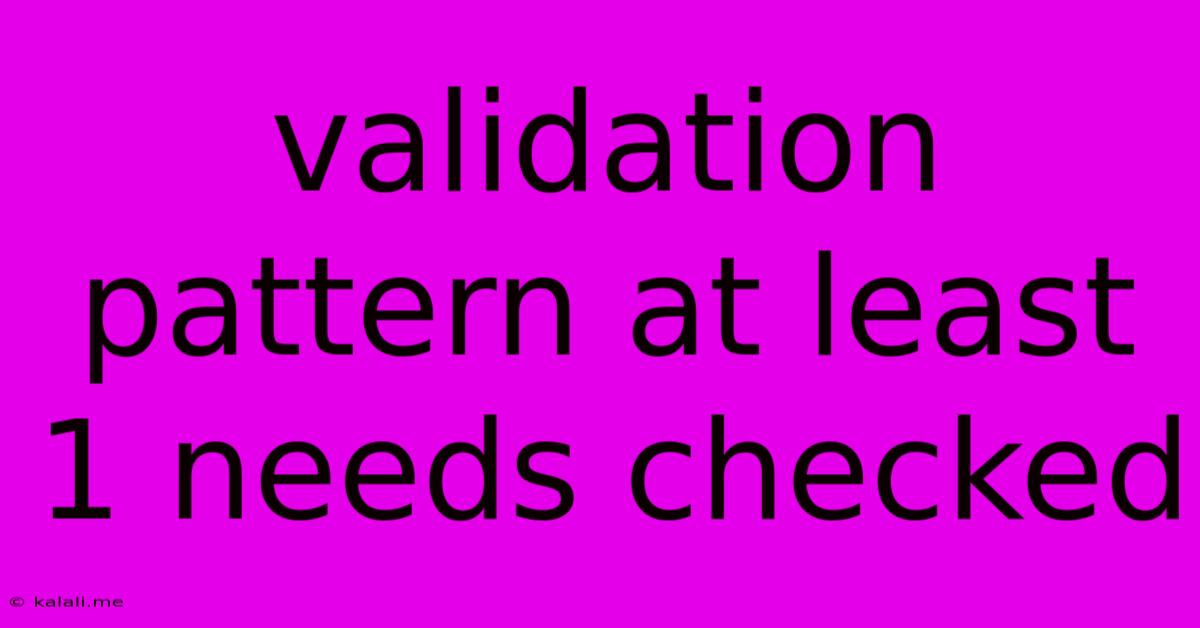Validation Pattern At Least 1 Needs Checked
Kalali
Jun 09, 2025 · 3 min read

Table of Contents
Validation Patterns: Ensuring At Least One Checkbox is Selected
This article dives into the crucial aspect of web form validation: ensuring that at least one checkbox in a group is selected before submission. This is a common requirement for many forms, from simple surveys to complex user registration processes. We'll explore different approaches, focusing on client-side validation using JavaScript for immediate feedback and improved user experience. We'll also briefly touch upon server-side validation for robust security.
Why is this important? Requiring at least one checkbox selection prevents incomplete or invalid submissions, ensuring data integrity and a smoother workflow. It also improves the user experience by providing clear guidance and immediate feedback, preventing frustration caused by unexpected errors.
Understanding the Problem
Let's imagine a simple form with multiple checkboxes representing different options. Without validation, a user could submit the form without selecting any options, leading to incomplete data. Our goal is to implement a mechanism that prevents this, alerting the user to select at least one option before proceeding.
Client-Side Validation with JavaScript
JavaScript offers the most efficient way to implement this type of validation. It provides immediate feedback to the user, improving the overall user experience. Here's how we can achieve this:
Method 1: Using querySelectorAll and a loop
This method iterates through all checkboxes within a specified container. It counts the number of checked boxes and displays an error message if none are selected.
const checkboxes = document.querySelectorAll('input[type="checkbox"]');
const errorMessage = document.getElementById('error-message');
const form = document.querySelector('form');
form.addEventListener('submit', (event) => {
let checkedCount = 0;
checkboxes.forEach(checkbox => {
if (checkbox.checked) {
checkedCount++;
}
});
if (checkedCount === 0) {
errorMessage.style.display = 'block';
event.preventDefault(); // Prevents form submission
} else {
errorMessage.style.display = 'none';
}
});
Remember to include an element with the ID error-message in your HTML to display the error message. For example: <p id="error-message" style="display:none; color:red;">Please select at least one option.</p>
Method 2: Using a single checkbox group with required attribute (Simpler Scenario)
If you have a single group of checkboxes related to a single question or option, you can simplify the process using the HTML5 required attribute. This requires a slight modification to your checkbox structure. You'll need a single container element (like a <fieldset> and <legend>) and then use the required attribute on that container. Any checkbox inside this fieldset must be selected.
This approach leverages the browser's built-in validation. It’s the most streamlined solution if applicable to your form structure.
Server-Side Validation
While client-side validation provides immediate feedback, it's crucial to implement server-side validation as well. This ensures data integrity even if a user bypasses client-side checks. Server-side validation should mirror the client-side checks, verifying that at least one checkbox is selected before processing the form data. This provides an added layer of security and prevents malicious submissions. The specific implementation depends on your server-side language and framework.
Best Practices
- Clear Error Messages: Provide users with clear and concise error messages explaining what they need to do to correct the issue.
- Accessibility: Ensure your validation is accessible to users with disabilities. Consider using ARIA attributes to improve screen reader compatibility.
- User Experience: Make the validation process as smooth and intuitive as possible. Avoid abrupt or jarring error messages.
- Combination of Client-Side and Server-Side Validation: Always use both to ensure data integrity and security.
By combining these techniques, you can create robust and user-friendly forms that ensure data integrity and a positive user experience. Remember to choose the method best suited for your specific form design and complexity.
Latest Posts
Latest Posts
-
How Long Would It Take To Drive 2000 Miles
Jul 01, 2025
-
What Color Does Black And Blue Make
Jul 01, 2025
-
How To Pass Level 7 In Bloxorz
Jul 01, 2025
-
How Much Years Is 1 Billion Minutes
Jul 01, 2025
-
I Reject Your Reality And I Substitute My Own
Jul 01, 2025
Related Post
Thank you for visiting our website which covers about Validation Pattern At Least 1 Needs Checked . We hope the information provided has been useful to you. Feel free to contact us if you have any questions or need further assistance. See you next time and don't miss to bookmark.